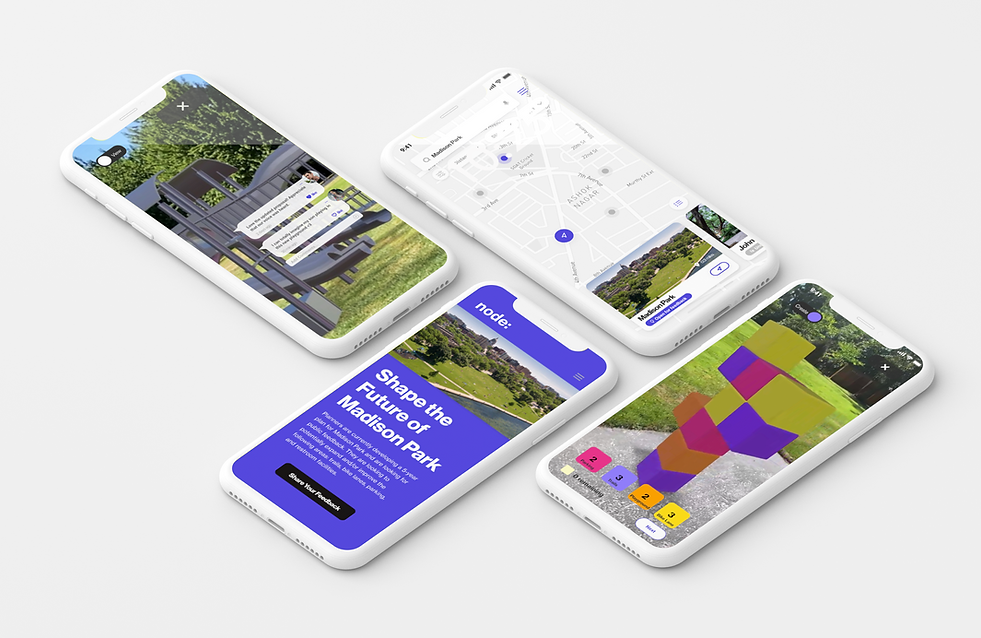
Node, an AR-Powered Urban Planning Tool using 5G Jun. - Aug., 2021
A conceptual product produced during Verizon's 10-week internship, Node is a platform that leverages augmented reality to get public feedback for urban planning projects, giving community members a voice in shaping the communities they live in. Node provides interactive and immersive experiences to make public engagement easier and more fun!
Duration: 10 weeks
Location: Remote
Design Tools: Figma, InVision, Vectary, Adobe AE
Teammate: Aichen Guo, Ruchi Vora, JD LeRoy,
Anna Zhang, Brendon Gross
My role:
-
Research & Analysis: secondary research, user interviews, affinity mapping, user journey
-
Design: ideation, storyboards, video scripts, paper prototypes, iterations, high-fidelity UI, interactive prototypes, decking
Introduction
DESIGN PROCESS
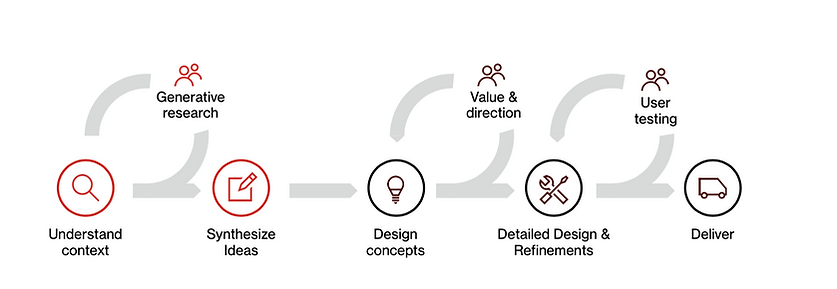
We were tasked with designing a near-future conceptual project that utilizes augmented reality to improve the experience of post-pandemic society, giving them the ability to engage with local communities.
After examining areas of impact like local journalism, food deserts, walkable cities, public art, and green spaces, the team decided on focusing on public engagement in urban planning.
WHY URBAN PLANNING?
During the pandemic, we noticed that the value of public spaces increased in our own communities. People were able to utilize these areas to engage safely with others and get some fresh air. Therefore, we sense that this field has great potential of using technology to empower residents to become co-creators of their cities.

User Research
INTERVIEWS
Objective: Understand the goals and challenges that urban planning professionals and community members face when engaging with each other
-
For urban planners and designers
Identify factors that contribute to current urban planning procedures, determine the amendability for these behaviors to change and the potential for AR to positively contribute to this process. -
For community members
Understand current engagement with urban planning processes in their community as well as determine the role AR might play in positively contributing to this process.
Sample size:
-
7 interviewees (4 community planners, 3 community members)
Methodology:
-
Participants were recruited through UserTesting.com
-
1-on-1 moderated individual sessions, conducted over Zoom, 60-minutes each
-
The users were asked a set of questions to ascertain their thoughts on the subject at hand. This protocol is not for collecting benchmark metrics such as time-on-task rates or statistical significance.
KEY RESEARCH INSIGHTS
After gathering information from 7 interviews, we used affinity diagram to organize all the information and gain insights from our research. We firstly put key info from interviews on sticky notes using Figma, then grouped them together into three main categories -- pandemic impacts, public engagement, and augmented reality.

Pandemic Impacts
COVID-19 has caused people to reaffirm the ways that they value public infrastructure. Yet, even in a presumed post-pandemic setting, there’s still concerns about group gathering. We therefore sense a need of using a remote & immersive approach to bring people to public spaces, and encourage them to participate in public engagement projects as a way of connecting with the community.

Public Engagement in Urban Planning
Everybody thinks there should be more opportunities for public engagement.
As one of the Planners said, “you never want community to think you’re designing without them in mind.” Community planners recognize the importance of getting the members’ feedback on plans and proposals.
Meanwhile, community members are interested in being actively engaged in their community’s planning processes.
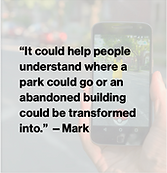
Augmented Reality
All participants think there is positive potential for AR in the public engagement process
Both planners and members think AR could be a great visualization tool for demonstrating potential developments and progress in people’s neighborhoods and gaining feedback. It can also help attract younger and tech-savvy participants.
MAPPING THE URBAN PLANNING PROCESS

PROBLEMS WITH URBAN PLANNING

Ideation
HOW MIGHT WE
With research insights in mind, we developed three HMW questions to direct our ideation.

SKETCHING
We had 2 minute design sprints as a team thinking through various AR solutions for each proposed opportunity area.
Then, we worked individually on concept drawings and regrouped as a team to share and discuss features for the product using Moscow Prioritization. At last, we discussed and reached consensus on the concepts for the AR solution.
We decided that we want to create an AR experience that allows community residents to discover urban planning projects and contribute their feedback in an engaging way.

Wireframing
INFORMATION ARCHITECTURE
Having some ideas about the AR solution, I built up an information architecture as a structure for our platform.

WIREFRAMES
With information architecture approved by the team, we then used InVision to draw out the paper prototype.

Branding & UI Design
We named our AR platform as "Node:" because a node is a point at which pathways intersect - it’s essentially the connecting point. The colon represents that the platform is a conversation starter in a community. Our goal is to enable everyone to have a voice in shaping the future of their community and to plan public spaces collectively.

Storyboard & Final Interactive Prototypes

To illustrate the concept of Node better, I incorporated storyboards to guide through the final interactive prototypes.
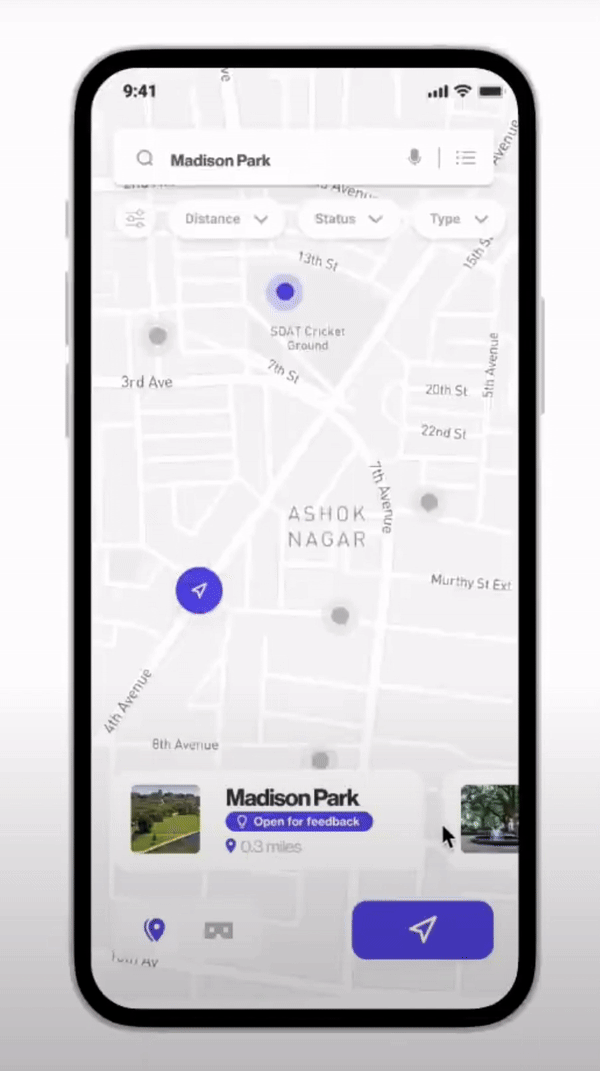
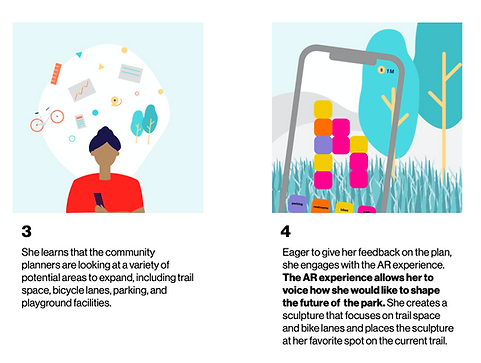

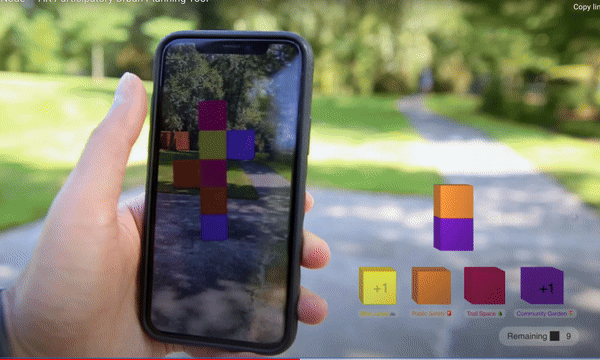
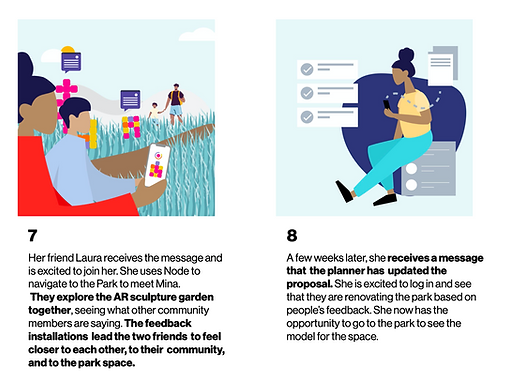




Features and Impacts




Strategy and Transformation
MOVING FORWARD
What are the next steps in this project or initiative?
Rollout plan: follow the strategy used to rollout 5G
-
Pilot in a second or third-tier city. The initial rollout of 5G did not target tier 1 cities like New York and San Francisco. In fact, 5G Home was introduced in places like Sacramento and Houston, and 5G Mobile was introduced in places like Minneapolis. Similarly, we would first bring Node to smaller cities that are more open to experimenting with emerging technology. We would then build on our learnings from that set of users, synthesize those findings, and make improvements accordingly.
-
Build on those learnings and key findings to scale to larger cities. Once it is proven in smaller towns, bigger cities are more likely to take it on and so piloting in second or third-tier cities will ideally help scale Node to larger areas and larger urban planning projects.
-
User testing to identify and resolve any issues with Node
TRANSFORMATION
5G makes it easier to connect communities and people, not just devices
-
Low latency, reliability, high throughput, energy efficiency, connected devices, data volume
-
Enables real-time immersive AR, real-time user response
-
Supports real-time data analysis of community needs
The low latency and high throughput of 5G enables Node to bring real-time immersive AR experiences for community members, allowing them to better engage with urban planning projects that are happening right in their neighborhoods. As we emerge from the pandemic, we hope that Node will empower community members to speak up about the changes they wish to see.
